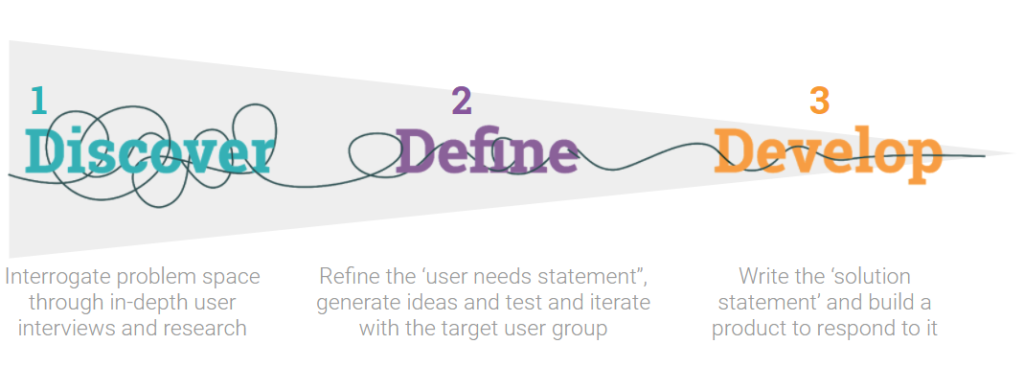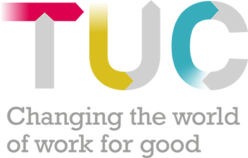Last year, we launched a new module in the TUC’s leadership development programme, Leading Change. It expands our long running course to also look at how digital can support (and challenge) senior union officers in managing change in their areas of work.
Given so many people have been through the course over the years, we have also offered it as a catch up module, which we’re now part way through running online with a great group of officers from across a dozen unions. We’re partnering with CAST (the Centre for the Acceleration of Social Technology) to run a very practical course, where participants pick a challenge they’re facing and design an intervention around it, using digital design methodologies.
There are other iterations of this model (with four or even five steps), but CAST use a three step approach to help structure the design process.

The Discover, Define, Develop model is a very helpful way of breaking down the stages of a product, and done well it leads into a loop that helps you start with small interventions, prove what works and move on to the next.
Discover: First you research the problem (check out “start with user needs and keep them involved” and “understand the problem before creating a solution” in our 8 digital principles for unions). Try to see it as the end user sees it. Too often we want to get others to fit into our own organisational perspective on a problem, and then wonder why they have little incentive to engage with what we produce.
Define: Next you need to find small steps towards solving the problem that you can test with real users. This helps you check if you’re on the right track. Here we’re looking at our principles around “being led by data” and “take small steps and learn as you go”.
Develop: Once you’ve tested whether people will engage with it, you can start to plan a larger development with more confidence. Hand up, in 25 years working in digital comms and projects, I’ve jumped straight to this stage far too often, which has in hindsight given my projects a lower strike rate than I could maybe have managed. This stage needs a good focus on our principle of “committing realistic resources”.
Involving users, testing your assumptions, following the data and iterating in small steps all helps you to reduce the risk of projects failing, and to make new interventions that much better fit what your end users will want from them.
Here’s an example that I used for the Leading Change course, to show how thinking in this way has helped us with a challenge we face at the TUC.
Our challenge: Signposting trade unions
Over the last couple of years, we’ve been looking at the problem of how we can more effectively recommend a union for someone to join.
We get around 10,000 people a month asking us this on the TUC site, and we want to make sure our unionfinder tool helps as many of those as we can to click through onto one of our affiliate unions’ websites, with the best chance that they’ll actually be able to join.
Discovering the scope
Back at the end of 2018, we looked into the problem with a 3 day design sprint.
We interviewed small samples of young workers in the private sector, where the question can be harder to answer than in the public sector or certain professions. We asked them how they thought about their work and how they might think the union finding process would ideally go if they wanted to join one.
We brought a small group of organisers from different affiliates into the design sprint, helping us to get wider perspectives than the TUC alone. And together we mapped out the steps involved for the user a researching a union to joining, and what the union was doing at each of those.
Looking at it from a user’s perspective rather than our own helped us to see some of the problems we hadn’t appreciated, such as how the definitions we are comfortable with for jobs and sectors often aren’t the ways in which people describe their own work.
We ended up with a number of user needs for the prospective joiners and also for the unions who might be welcoming them.
And we had a set of How Might We statements, which pointed the way to a number of areas where we could make useful interventions.
Defining the project
Over the last two years, this discovery phase has given us a rich vein of different projects, addressing different aspects of the wider challenge, and building on our learning all the time.
One of the original solution statements we had was that we wanted to streamline our process to help people find and join a union in under five minutes. Unions have made some great progress in their own systems (check out our recent report on this), and we wanted to make sure our part of the journey was helping as much as possible.
For this, we identified a number of aspects we could vary and test, in terms of design and flow, length of content and steps we could add or omit from the process.
Whilst we were planning the changes, we temporarily added a chat function to the tool, using Zendesk. This was great for research as we could set the chat button to only show if one of us was live online – that way we didn’t have to resource the service full time. The chat let us help real users through the process live and gave us good insights into who they were, and how they saw their situation in looking for a union.
We ran the changes to our new processes as a live prototype. Working with engagement optimisation agency Forward Action, we built a basic web application that was nice looking but minimal behind the scenes. And we integrated it with free tracking tools to measure how real users were responding to it.
Every couple of weeks we switched options, picking a winner and moving on to test the next potential change. For example, showing more content up front stopped people getting past the first stage, and therefore reduced the number who completed it. Or adding an optional request for an email address during the process reduced total completions by 2% but got us ongoing contact with 15% of users, to support them in joining after they had used the wizard.
Looking into the results of the live test in a workshop together helped us gain a better understanding of how we could make our tool as efficient as possible, that was grounded in real user behaviour, not just our own hunches.
Developing the service
And since gaining that learning on the most effective process, we’ve been working to integrate it with our wider website.
The service has now been built more robustly, integrated with our reporting channels and and Content Management System (Drupal 8), so it’s possible for us to maintain the content ourselves ongoing, in terms of the texts and images we use, or when descriptions and categorisation of unions change.
It would have been a bigger risk for us to develop the whole tool based on our assumptions before the define stage. And it would have cost more to make the tweaks we did to a fully developed web application, rather than just the prototype.
The discovery phase also means we have been able to deliver the revised tool with a view to making it easier to test the next stages we want to work on.
These are going to be around how we present unions to encourage clearer choices, how we measure and improve the rates at which people actually join the unions we recommend, and how we can best follow up with users to get them through the process after they leave our web page.
—–
(And for those who might be interested, we’re hoping to run a new in-person intake of the full Leading Change programme for 2021, starting towards the end of the year. Get in touch with our national organising and training manager Carl Roper if you’re interested)
